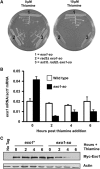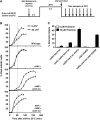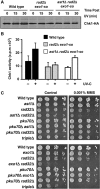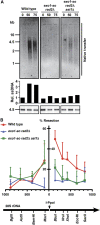Initiation of DNA damage responses through XPG-related nucleases
- PMID: 23211746
- PMCID: PMC3553381
- DOI: 10.1038/emboj.2012.322
Initiation of DNA damage responses through XPG-related nucleases
Abstract
Lesion-specific enzymes repair different forms of DNA damage, yet all lesions elicit the same checkpoint response. The common intermediate required to mount a checkpoint response is thought to be single-stranded DNA (ssDNA), coated by replication protein A (RPA) and containing a primer-template junction. To identify factors important for initiating the checkpoint response, we screened for genes that, when overexpressed, could amplify a checkpoint signal to a weak allele of chk1 in fission yeast. We identified Ast1, a novel member of the XPG-related family of endo/exonucleases. Ast1 promotes checkpoint activation caused by the absence of the other XPG-related nucleases, Exo1 and Rad2, the homologue of Fen1. Each nuclease is recruited to DSBs, and promotes the formation of ssDNA for checkpoint activation and recombinational repair. For Rad2 and Exo1, this is independent of their S-phase role in Okazaki fragment processing. This XPG-related pathway is distinct from MRN-dependent responses, and each enzyme is critical for damage resistance in MRN mutants. Thus, multiple nucleases collaborate to initiate DNA damage responses, highlighting the importance of these responses to cellular fitness.
Figures







Similar articles
-
XPG-related nucleases are hierarchically recruited for double-stranded rDNA break resection.J Biol Chem. 2019 May 10;294(19):7632-7643. doi: 10.1074/jbc.RA118.005415. Epub 2019 Mar 18. J Biol Chem. 2019. PMID: 30885940 Free PMC article.
-
Release of Ku and MRN from DNA ends by Mre11 nuclease activity and Ctp1 is required for homologous recombination repair of double-strand breaks.PLoS Genet. 2011 Sep;7(9):e1002271. doi: 10.1371/journal.pgen.1002271. Epub 2011 Sep 8. PLoS Genet. 2011. PMID: 21931565 Free PMC article.
-
Role of the DNA repair nucleases Rad13, Rad2 and Uve1 of Schizosaccharomyces pombe in mismatch correction.J Mol Biol. 2001 Oct 19;313(2):241-53. doi: 10.1006/jmbi.2001.5054. J Mol Biol. 2001. PMID: 11800554
-
Establishment of and recovery from damage checkpoint requires sequential interactions of Crb2 with protein kinases Rad3, Chk1, and Cdc2.Cold Spring Harb Symp Quant Biol. 2000;65:443-9. doi: 10.1101/sqb.2000.65.443. Cold Spring Harb Symp Quant Biol. 2000. PMID: 12760060 Review. No abstract available.
-
The G(2) DNA damage checkpoint: could this ancient regulator be the Achilles heel of cancer?Cancer Biol Ther. 2009 Aug;8(15):1433-9. doi: 10.4161/cbt.8.15.9081. Epub 2009 Aug 22. Cancer Biol Ther. 2009. PMID: 19574738 Review.
Cited by
-
Human DNA polymerase delta double-mutant D316A;E318A interferes with DNA mismatch repair in vitro.Nucleic Acids Res. 2017 Sep 19;45(16):9427-9440. doi: 10.1093/nar/gkx611. Nucleic Acids Res. 2017. PMID: 28934474 Free PMC article.
-
Molecular mechanisms involved in initiation of the DNA damage response.Mol Cell Oncol. 2015 Jan 23;2(1):e970065. doi: 10.4161/23723548.2014.970065. eCollection 2015 Jan-Mar. Mol Cell Oncol. 2015. PMID: 27308403 Free PMC article. Review.
-
XPG-related nucleases are hierarchically recruited for double-stranded rDNA break resection.J Biol Chem. 2019 May 10;294(19):7632-7643. doi: 10.1074/jbc.RA118.005415. Epub 2019 Mar 18. J Biol Chem. 2019. PMID: 30885940 Free PMC article.
-
Dna2 is involved in CA strand resection and nascent lagging strand completion at native yeast telomeres.J Biol Chem. 2013 Oct 11;288(41):29414-29. doi: 10.1074/jbc.M113.472456. Epub 2013 Aug 20. J Biol Chem. 2013. PMID: 23963457 Free PMC article.
-
Studying DNA Double-Strand Break Repair: An Ever-Growing Toolbox.Front Mol Biosci. 2020 Feb 21;7:24. doi: 10.3389/fmolb.2020.00024. eCollection 2020. Front Mol Biosci. 2020. PMID: 32154266 Free PMC article. Review.
References
Publication types
MeSH terms
Substances
Grants and funding
LinkOut - more resources
Full Text Sources
Molecular Biology Databases
Miscellaneous

